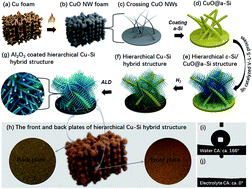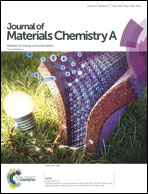A bottom-up synthetic hierarchical buffer structure of copper silicon nanowire hybrids as ultra-stable and high-rate lithium-ion battery anodes†
Abstract
Silicon (Si) is a promising anode material for next-generation high-energy lithium-ion batteries (LIBs). However, large volume changes and low intrinsic electrical conductivity of silicon materials result in poor cycle performances, especially at a high Si loading. To tackle the two critical problems, we here report an Al2O3 coated hierarchical copper–silicon nanowire structure (HCS NW) using a crossing-interconnected-hierarchical-hollow (CIHH) bottom-up strategy. This architecture provides multiple-electron transport pathways, ultra-stable mechanical supports and leaves enough room for the free expansion and contraction of silicon during cyclings. Because of this arrangement, the HCS NW hybrid structures exhibit an outstanding cycling stability (∼830 mA h g−1 and 85% capacity retention after 800 cycles) and high areal capacity (∼3.5 mA h cm−2) at a high Si mass loading. Notably, the copper–silicon alloy trunk shows an ultra-long cycle lifespan of more than 6000 cycles and the Li-inactive Cu3Si is confirmed for the first time. This work paves the way to develop ultra-long cycle life Si anodes, particularly at high mass loading, and provides new avenues for the rational engineering of high-rate electrode materials.



 Please wait while we load your content...
Please wait while we load your content...